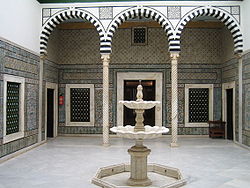Le Bardo: Difference between revisions
Content deleted Content added
Jbribeiro1 (talk | contribs) Added {{unreferenced}} tag to article (TW) |
m out of Tunis |
||
| Line 134: | Line 134: | ||
{{Authority control}} |
{{Authority control}} |
||
[[Category:Tunis|Bardo, le]] |
|||
[[Category:Populated places in Tunis Governorate]] |
[[Category:Populated places in Tunis Governorate]] |
||
[[Category:Communes of Tunisia]] |
[[Category:Communes of Tunisia]] |
||
[[Category:World Digital Library related]] |
[[Category:World Digital Library related]] |
||
{{tunisia-geo-stub}} |
{{tunisia-geo-stub}} |
||
Revision as of 20:21, 6 August 2015
Le Bardo | |
|---|---|
 | |
| Country | |
| Governorate | Tunis Governorate |
| Population (2004) | |
| • Total | 73,953 |
| Time zone | UTC1 (CET) |
Le Bardo (also Bārdaw, Bardaw, and Bardois) is a Tunisian city west of Tunis. As of 2004, the population is 73,953.
Built by the Hafsid dynasty in the 15th century, the name Bardo comes from the Spanish word "prado" meaning a garden. Bardo became a residence of the Tunis court in the 18th century. With the arrival of Husseinite beys, Bardo became a political, intellectual and religious center. The ancient beys residence was actually the site of the Tunisian National Assembly headquarters, and the National Museum opened there in 1882.
The city gave its name to the Treaty of Bardo, signed in nearby Ksar Saïd palace, which placed Tunisia under French protectorate in 1881.
